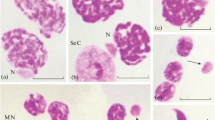Summary
The mutagenic response of the various stages of spermatogenesis to the action of 2:4:6-tri(ethyleneimino)-l:3:5-triazine has been investigated by the brood technique. The treated male was mated to a succession of virgin females at set intervals, and the mutation rate was scored separately in each brood. The mutation rate/brood relationship for the same genetic property varied in the different experiments. It was found to depend on the structure of the testis at the time of treatment and the gross morphological changes induced in it by the mutagen. Another controlling factor is the way the male germ line is fractionated among the broods, which varies with the rate of germ-cell differentiation and the brood interval. To reduce variability between experiments a standard technique was adopted. The treated males were of the same strain, age and size, were reared under the same culture conditions and their progeny was fractionated at fixed intervals.
Similar content being viewed by others
References
Auerbach, C. (1950). Differences between effects of chemical and physical mutagens.Pubbl. Staz. Zool. Napoli (Suppl.),22, 1.
Auerbach, C. (1952). Mutation tests onDrosophila melanogaster with aqueous solutions of formaldehyde.Amer. Nat.86, 330.
Auerbach, C. (1954). Sensitivity of theDrosophila testis to the mutagenic action of X-rays.Z. indukt. Abstamm. u. VererbLehre,86, 113.
Belgovsky, M. L. (1938). Influence of inert regions of chromosomes on the frequency of occurrence and type of changes in the adjacent active sections.Izv. Akad. Nauk. U.S.S.R., Ser. Biol.,1, 1017.
Belgovsky, M. L. (1939). Dependence of the frequency of minute chromosome rearrangements inDrosophila melanogaster upon X-ray dosage.Izv. Alcad. Nauk. U.S.S.R., Ser. Biol.,2, 159.
Bird, M. J. amp;Fahmy, O. G. (1953). Cytogenetic analysis of the action of carcinogens and tumour inhibitors inDrosophila melanogaster. I. l:2,3:4-diepoxybutane.Proc. Roy. Soc. B,140, 556.
Bridges, C. B. (1936). The Bar ‘gene’ a duplication.Science,83, 210.
Cooper, K. W. (1950). Normal spermatogenesis inDrosophila. Chapter inThe Biology of Drosophila. New York: Shon Willey and Sons. Inc..
Demerec, M. amp;Fano, U. (1941). Mechanism of the origin of the X-ray inducedNotch deficiencies inDrosophila melanogaster.Proc. Nat. Acad. Sci., Wash.,27, 24.
Demerec, M. amp;Hoover, M. E. (1936). Three related X-chromosome deficiencies inDrosophila.J. Hered.26, 206.
Demerec, M. amp;Hoover, M. E. (1939).Hairy-wing-a duplication inDrosophila melanogaster.Genetics,24, 271.
Fahmy, O. G. amp;Bird, M. J. (1953). Chromosome breaks among recessive lethals induced by chemical mutagens inDrosophila melanogaster.Heredity,6, 149, Suppl.
Fahmy, M. J. amp;Fahmy, O. G. (1952). Chemical mutagenesis inDrosophila and its cytogenetic analysisB.E.C.C..Ann. Rep.13, 39.
Fahmy, O. G. amp;Fahmy, M. J. (1954). Cytogenetic analysis of the action of carcinogens and tumour inhibitors inDrosophila melanogaster. II. The mechanism of induction of dominant lethals by 2:4:6-tri(ethyleneimino)-l:3:5-triazine.J. Genet.52, 603.
Fahmy, O. G. amp;Fahmy, M. J. (1955). Cytogenetic analysis of the action of carcinogens and tumour inhibitors inDrosophila melanogaster. III. Chromosome structural changes induced by 2:4:6. tri(ethyleneimino)-l:3:5-triazine.J. Genet.53, 181.
Goldschmidt, R. (1938).Physiological Genetics. New York: McGraw-Hill.
Haldane, J. B. S. amp;Lea, D. E. (1947). A mathematical theory of chromosome rearrangements.J. Genet.48, 1.
Lea, D. E. amp;Catcheside, D. G. (1945). Recessive lethals, dominant lethals, and chromosome aberrations inDrosophila.J. Genet.47, 10.
Lüning, K. G. (1952a). X-ray induced chromosome breaks inDrosophila melanogaster.Hereditas, Lund,38, 321.
Lüning, K. G. (1952b). Studies on the origin of apparent gene mutations inDrosophila melanogaster.Acta Zool.33, 193.
McClintock, B. (1938). The production of homozygous deficient tissues with mutant characteristics by means of the aberrant mitotic behaviour of ring-shaped chromosomes.Genetics,23, 315.
McClintock, B. (1944a). The relation of homozygous deficiencies to mutations and allelic series in maize.Genetics,29, 478.
McClintock, B. (1944b). Maize genetics.Yearb. Garneg. Instn.43, 127.
Morgan, T. H., Bridges, C. B. amp;Sohultz, J. (1937). The gene. Ann. Rep. Dep. Genet.,Yearb. Garneg. Instn,36, 301.
Muller, H. J. (1935a). A viable two gene deficiency.J. Hered.26, 469.
Muller, H. J. (1935b). The origination of chromatin deficiencies as minute deletions subject to insertion elsewhere.Genetica,17, 237.
Muller, H. J. (1941). Resume and perspectives of the symposium on genes and chromosomes.Cold Spr. Harb. Symp. Quant. Biol.9, 290.
Muller, H. J. amp;Mackenzie, K. (1939). Discriminatory effect of ultra-violet rays on mutation inDrosophila.Nature, Lond.,143, 83.
Muller, H. J., Prokofyeva, A. A. amp;Raffel, D. (1935). Minute intergenic rearrangement as a cause of apparent ‘gene mutation’.Nature, Lond.,135, 253.
Serebrovsky, A. S. (1929). A general scheme for the origin of mutations.Amer. Nat.63, 374.
Slizynska, H. amp;Slinzyski, B. M. (1947). Genetical and cytological studies of lethals induced by chemical treatment inDrosophila melanogaster.Proc. Roy. Soc. Edinb. B,62, 234.
Vogt, M. (1950). Ergänzende Befunde zur Mutagenen Wirkung der Urethane (Carbaminsaureester) beiDrosophila.Z. indukt. Abstamm. u. VererbLehre,93, 341.
Author information
Authors and Affiliations
Rights and permissions
About this article
Cite this article
Fahmy, O.G., Fahmy, M.J. Cytogenetic analysis of the action of carcinogens and tumour inhibitors inDrosophila melanogaster iv. The cell stage during spermatogenesis and the induction of intra and inter-genic mutations by 2:4:6-tri(ethyleneimino)-1: 3:5-triazine. J Genet 53, 563–584 (1955). https://doi.org/10.1007/BF02981675
Received:
Issue Date:
DOI: https://doi.org/10.1007/BF02981675



